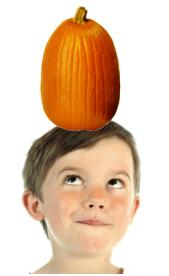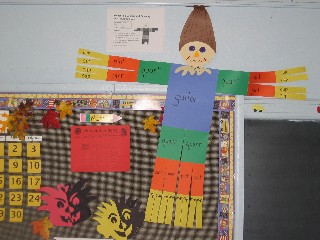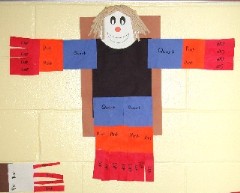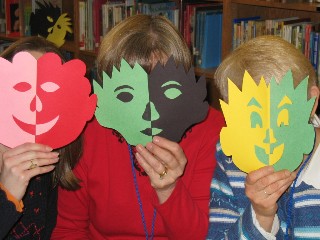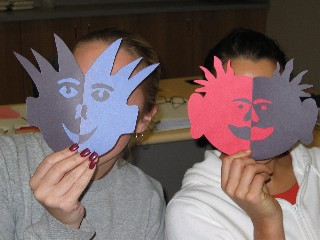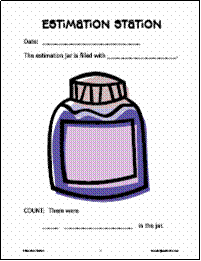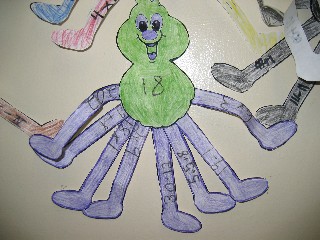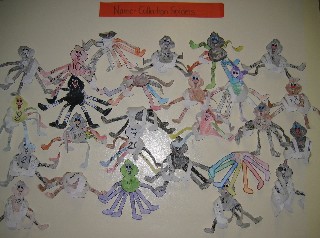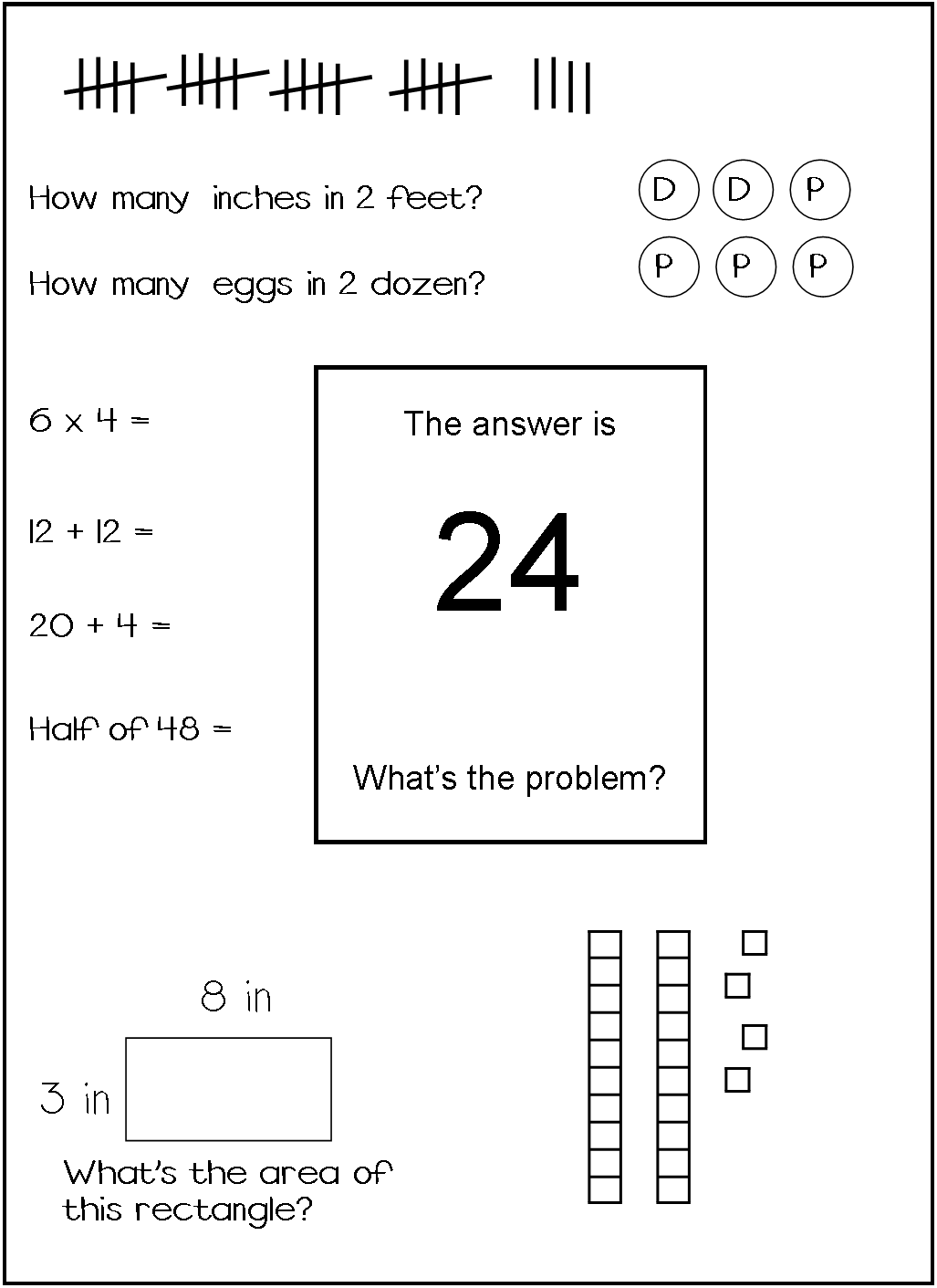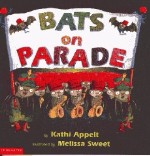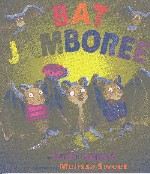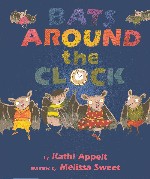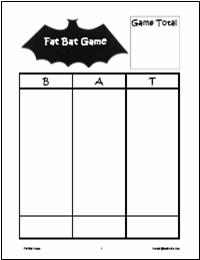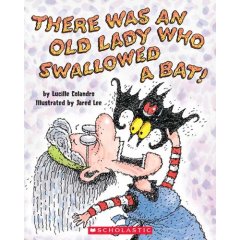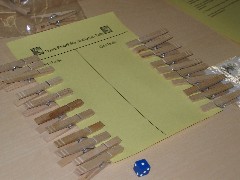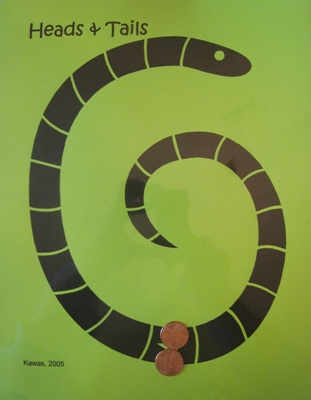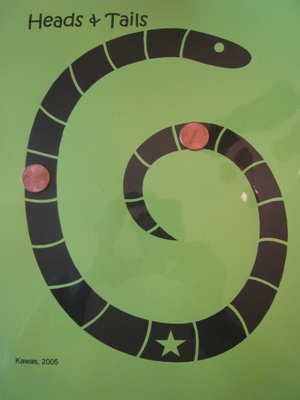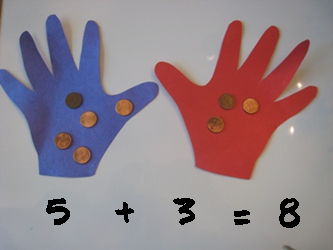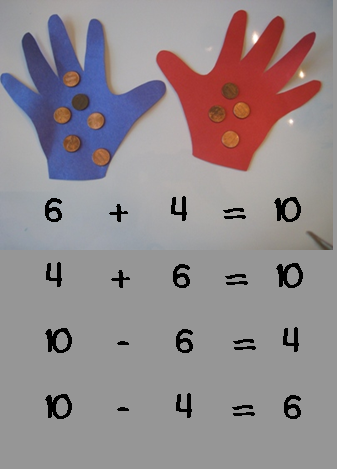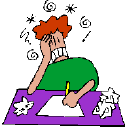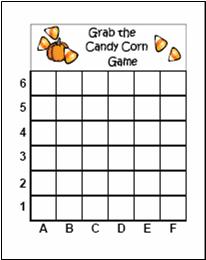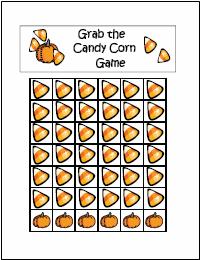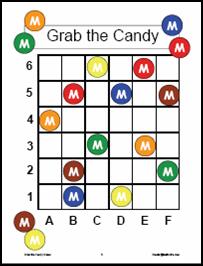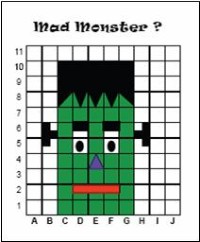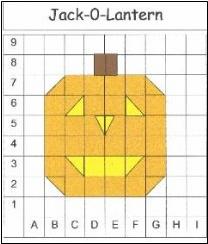How Many Ghosts Do You See?
This activity encourages students to apply the patterns in Pascal's Triangle. A teacher instructional plan with mathematical background, answer and challenge is included to explain how to present this problem, which is also an outgrowth of the Rutgers Discrete Math Institute.
A recording sheet is also included as part of the teacher packet so that students are able to record all different solutions using a systematic counting method, which is a goal of discrete mathematics.
Download Pascal's Ghosts problem, instructional plan, student recording sheet and answer key.
Be sure to check out Pascal's Pumpkins in an earlier post. This is an easier introduction to the patterns in Pascal's triangle.

Friday, October 28, 2011
Thursday, October 27, 2011
Fall Problem Solving
These open-ended assessments require students to apply mathematical concepts and skills to solve problems and explain their thinking using words, pictures and/or numbers.
 Candy Corn presents a triangular numbers problem using a candy corn pattern. Younger students might use candy corn to model the problem. A sample solution shows how older students might use an input-output table to model the pattern and find the solution without the use of manipulatives.
Candy Corn presents a triangular numbers problem using a candy corn pattern. Younger students might use candy corn to model the problem. A sample solution shows how older students might use an input-output table to model the pattern and find the solution without the use of manipulatives.
 Annual Fall Parade challenges students to use the triangular pattern to figure out how many students are in the fourth grade. Given the number of full rows, students must apply the pattern and use effective recording (picture, table, etc.) to explain their reasoning.
Annual Fall Parade challenges students to use the triangular pattern to figure out how many students are in the fourth grade. Given the number of full rows, students must apply the pattern and use effective recording (picture, table, etc.) to explain their reasoning.
 Pumpkin Picking is a pattern problem that can be solved using a picture or an input/output table. [contributed by Shannon Collier, Joseph C. Caruso School, Keansburg, NJ]
Pumpkin Picking is a pattern problem that can be solved using a picture or an input/output table. [contributed by Shannon Collier, Joseph C. Caruso School, Keansburg, NJ]
 Trick or Treat requires students to create a table of values and identify the pattern or rule to solve the problem.
Trick or Treat requires students to create a table of values and identify the pattern or rule to solve the problem.
 Grade 2 Halloween Word Problems were written by Tammie Holcombe and Karen Zeigler, second grade teachers at Port Monmouth Road School in Keansburg, NJ.
Grade 2 Halloween Word Problems were written by Tammie Holcombe and Karen Zeigler, second grade teachers at Port Monmouth Road School in Keansburg, NJ.
Younger students will enjoy analyzing and completing Fall Patterns. They should then classify the pattern and explain their reasoning as part of the class discussion. It is possible that students will see different patterns in some of the items so their explanation and justification are very important mathematical discourse.
Fall Patterns. They should then classify the pattern and explain their reasoning as part of the class discussion. It is possible that students will see different patterns in some of the items so their explanation and justification are very important mathematical discourse.
 Candy Corn presents a triangular numbers problem using a candy corn pattern. Younger students might use candy corn to model the problem. A sample solution shows how older students might use an input-output table to model the pattern and find the solution without the use of manipulatives.
Candy Corn presents a triangular numbers problem using a candy corn pattern. Younger students might use candy corn to model the problem. A sample solution shows how older students might use an input-output table to model the pattern and find the solution without the use of manipulatives. Annual Fall Parade challenges students to use the triangular pattern to figure out how many students are in the fourth grade. Given the number of full rows, students must apply the pattern and use effective recording (picture, table, etc.) to explain their reasoning.
Annual Fall Parade challenges students to use the triangular pattern to figure out how many students are in the fourth grade. Given the number of full rows, students must apply the pattern and use effective recording (picture, table, etc.) to explain their reasoning. Pumpkin Picking is a pattern problem that can be solved using a picture or an input/output table. [contributed by Shannon Collier, Joseph C. Caruso School, Keansburg, NJ]
Pumpkin Picking is a pattern problem that can be solved using a picture or an input/output table. [contributed by Shannon Collier, Joseph C. Caruso School, Keansburg, NJ] Trick or Treat requires students to create a table of values and identify the pattern or rule to solve the problem.
Trick or Treat requires students to create a table of values and identify the pattern or rule to solve the problem. Grade 2 Halloween Word Problems were written by Tammie Holcombe and Karen Zeigler, second grade teachers at Port Monmouth Road School in Keansburg, NJ.
Grade 2 Halloween Word Problems were written by Tammie Holcombe and Karen Zeigler, second grade teachers at Port Monmouth Road School in Keansburg, NJ.Younger students will enjoy analyzing and completing
 Fall Patterns. They should then classify the pattern and explain their reasoning as part of the class discussion. It is possible that students will see different patterns in some of the items so their explanation and justification are very important mathematical discourse.
Fall Patterns. They should then classify the pattern and explain their reasoning as part of the class discussion. It is possible that students will see different patterns in some of the items so their explanation and justification are very important mathematical discourse.
Labels:
fall,
math seasonal activities,
patterns,
problem solving
Wednesday, October 26, 2011
Measurement Man
 Measurement Man scarecrows to visually represent the relationship between gallon, quart, pint, cup. This conceptual image provides a visual body cue when students need to use these references in the future or on state testing.
Measurement Man scarecrows to visually represent the relationship between gallon, quart, pint, cup. This conceptual image provides a visual body cue when students need to use these references in the future or on state testing.Measurement equivalents are always a tough challenge in elementary classrooms. This visual helps students master the equivalent units and helps them compare and rename these common measurement units.
Tuesday, October 25, 2011
Symmetric Faces
Halloween masks become a math activity when students create Symmetric Faces. Students demonstrate a working knowledge of symmetry as they make these unique masks using 1.5 sheets of construction paper, scissors and glue. Students outline the features on the half-sheet of paper, then carefully cut the pieces, and position them on the opposite side to create a symmetric face in opposite colors.
Download directions for making
 Symmetric Faces.
Symmetric Faces.Don't limit this mask activity to Halloween, as these versions would be equally effective opportunities to introduce this symmetry project:
- Patriotic masks created in red, white and blue
- Mardi Gras masks using yellow, green, and purple construction paper combinations to simulate Mardi Gras colors.
- School Spirit masks created in school colors
- Valentine masks created in red, pink and white
- Or...you get the idea!
Be sure to check out the Symmetric Faces Photo Gallery for more inspiration.
Monday, October 24, 2011
Estimation Station
Establish a regular center in the room which changes weekly. A simple clear plastic container is filled with different items each week. These items should vary in size to challenge students' developing concept of volume, as it relates to smaller or larger units. Use seasonal items: acorns, leaves, candy corn, popcorn kernels, pumpkin seeds, etc. to spark student interest. Keep a class journal of these activities in which students may record their estimates. Record the item and the actual count along with a digital picture, if possible, of the container and the student(s) whose estimates were closest. Some classes involve parents by asking for volunteers to send in appropriate items to be counted. It is important to use the same container for several weeks so that students build an understanding that size matters in estimating how many items there are in the jar.
- Download
 Estimation Station Recording Sheets to use for this activity. Keep sheets in a binder to provide a growing record of student growth in estimating.
Estimation Station Recording Sheets to use for this activity. Keep sheets in a binder to provide a growing record of student growth in estimating. - Suggestions for using recording sheets: Have each student write his/her name and estimate on Page 2. After counting, circle or color in the student(s) whose estimates were closest. Teachers may elect to print in names at the beginning of the year and simply copy each week so that student names are always in the same location for easy checking.
- Take a picture: Use a digital camera to record the winner(s) holding the jar each week. Add the picture to page one by simply covering the estimation jar clip art.
- Read more about these pumpkin activities in
 Pumpkins, Pumpkins Everywhere.
Pumpkins, Pumpkins Everywhere.
Friday, October 21, 2011
Spider Names
Ms. Collier's and Ms. Rachko's classes created Name-Collection spiders for Halloween. These fourth grade students extended the Everyday Math name-collection box routine to writing 8 different names for each number, one for each spider leg.
This activity builds on students' ability to recognize and create different names for the same number. NCTM originally proposed the open-ended activity:
Students are encouraged to write questions drawn from all areas of mathematics for which the answer is 24. Here's an example of a student's response:
This activity is easily used as a transition activity. Students complete the activity as the teacher checks homework or distributes materials. Make it a once a week activity, copy the best responses onto chart paper and post it in the classroom for student reference.
Thursday, October 20, 2011
Bats on Parade
This book is a literary introduction to square numbers and the patterns they form as square arrays. The bats march in parade formation and different sections of the band, being different sizes, march in different arrays: "In nine rows of nine those trombones reported, while there, right behind them, the tubas retorted." The pictures and rhyme reinforce the mathematics of the patterns and teachers can easily ask students to predict how many bats will be in the next section or ask them to figure out how many bats are in the whole band before reading those pages. Add this book to your collection of problem-solving literature prompts.
Bat Jamboree introduces the triangular number pattern as bats assemble for the final number beginning with 10 bats in the bottom row, 9 in the next row, etc. to the very top row with 1 bat. Students are introduced to the 55 bats in formation and their various acts but the book "isn't over until the bat lady sings." Students will enjoy this introduction to an important mathematical pattern. Teachers can find many problems that build upon this triangular number pattern and extend the experience.
- Multiplication Arrays: The book is a great introduction to multiplication arrays. Use the book illustrations to show students how to use an array to model a multiplication problem then ask students to create arrays for different multiplication facts.
- Class on Parade Book: Challenge students to design an array and a rhyme for an original page in theClass on Parade book. Decide on a theme and let pairs of students work on both the math and the language for a page.
Bat Jamboree by Kathi Appelt
- Student Written Problems: ask students to write original problems that use the triangular number pattern. Being able to write similar problems and solve them require higher-order thinking skills as students apply, synthesize and evaluate both the problems and the solutions.
Bats Around the Clock by Kathi Appelt
Take a humorous dance through time. Click Dark and American Batstand introduce a new dance each hour. Students move through time, enjoy some rhyme and learn the names of some oldie-but-goodie dances along the way.- Making Time: For the second reading, give students individual clocks and ask them to move the hour hand to the next hour and say the time before reading the book section for that hour.
- School Time: Provide copies of the
 School Time Template and have students choose a time in the school day, draw the hands on the clock, write a verse and draw an illustration that shows what the class does during that hour. Assemble the individual hours into a class booklet or booklets, depending on the number of students in the class. This activity is easily differentiated to feature time on the hour, or to use the real time schedule of activity changes the class follows. The template clock deliberately shows no hands, allowing teachers to customize the activity to the appropriate mathematical level of students in the class.
School Time Template and have students choose a time in the school day, draw the hands on the clock, write a verse and draw an illustration that shows what the class does during that hour. Assemble the individual hours into a class booklet or booklets, depending on the number of students in the class. This activity is easily differentiated to feature time on the hour, or to use the real time schedule of activity changes the class follows. The template clock deliberately shows no hands, allowing teachers to customize the activity to the appropriate mathematical level of students in the class.
Monday, October 17, 2011
Fat Bat Game
Students roll a die to see how many insects their bat eats. Students may continue rolling, in this Bat version of Pig, until they elect to stop, or until they roll a 1. But be careful! If your bat is still eating (collecting points) when a one is tossed, you are a Fat Bat and lose all of your points for that round.
This game is designed to provide a fun experience in the experimental probability of a single die toss. However, students get lots of practice adding a string of single digit numbers, as they total up their winning points for each round. A data analysis option is included to formally extend the analysis of the game's probability for older students.
Download Fat Bat for the student recording sheet, directions for whole class play, and data analysis option for extending the game.
Sunday, October 16, 2011
Bat Probability
There Was An Old Lady Who Swallowed A Bat!
by Lucille Colandro
After reading the book, investigate Batty Old Lady Probability. Students spin to collect all of the items the Batty Old Lady swallowed, and tally each spin on the recording sheet. They then calculate the total spins it took them to get all 7 items, and add that figure to the class data. Teachers may help students analyze the class data and learn about probability in the process. The pdf document includes directions, game mat, picture cards, spinner, recording sheet and writing to learn handout.
by Lucille Colandro
After reading the book, investigate Batty Old Lady Probability. Students spin to collect all of the items the Batty Old Lady swallowed, and tally each spin on the recording sheet. They then calculate the total spins it took them to get all 7 items, and add that figure to the class data. Teachers may help students analyze the class data and learn about probability in the process. The pdf document includes directions, game mat, picture cards, spinner, recording sheet and writing to learn handout.
Labels:
bat,
data,
data collection,
math-literature connection,
probability
Friday, October 14, 2011
Pumpkin Graphing
This month's featured graphing format is the clothespin graph which captures data from simple yes-no questions. Use a piece of oaktag or foam board to construct the actual graph part that is reused. Write the question on a sheet of paper and attach it to the top of the board. Provide clothespins for students to use to affix to the yes or no side of the graph. Some teachers write student names on the clothespins so that it is easy to see who did or didn't vote yet.
A clothespin graph may also be used to record data for any two-choice option.
|
Wednesday, October 12, 2011
Pumpkin Jumble Game
Students toss a die to get pattern blocks to add to create a jack-o-lantern face. The first person to complete his/her jack-o-lantern wins the game. This game develops the concept of probability of a single die as students also have opportunities for Lucky or Unlucky tosses that add a twist to the game.
Data Collection & Analysis: This simple game provides a great opportunity for data collection and analysis of the probability of a one-die toss.
Have students use the recording sheet to capture each die toss. After completing the game, students may add their results to a class data table to see if each number does indeed have an equal chance of winning.
Data Collection & Analysis: This simple game provides a great opportunity for data collection and analysis of the probability of a one-die toss.
Have students use the recording sheet to capture each die toss. After completing the game, students may add their results to a class data table to see if each number does indeed have an equal chance of winning.
- Download the Pumpkin Jumble game mat.
- Download the recording sheet to capture data for class analysis.
Tuesday, October 11, 2011
Pascal's Pumpkins
Pascal's Pumpkins encourages students to look for patterns in Pascal's Triangle. The handout develops awareness of this important mathematical pattern through a timely seasonal activity.
Students who take higher math courses will meet Pascal again in many different applications, including probability. This handout is an outgrowth of the Rutgers Discrete Math Institute.
Download Pascal's Pumpkins handout and solution.
Sunday, October 9, 2011
Heads & Tails Game
The Heads & Tails Game was designed to introduce young students to the probability of a single coin toss. By playing the game and adding results to a class tally, students will learn that the outcomes of heads and tails are equally likely.
To start the game, each player places a penny on the star of the snake. The heads player places the penny heads side up. The tails player places the penny tails side up.
The heads player tosses a coin. If it is heads, he moves the penny one space toward the head of the snake. If it is tails, he does not move but the tails player moves her coin one space toward the tail.
Next, the tails player tosses a coin. If it is tails, she moves her penny one space toward the tail of the snake. If it is heads, she does not move but the heads player moves his penny one space toward the head of the snake.
Play continues back and forth until one of the players reaches either the head or the tail of the snake, thereby winning the game.
The players post their results on the classroom tally, adding to the Heads Won or Tails Won count. Players should play several games, if possible, to create a large sample which more closely approximates the actual probability.
Download the Heads & Tails game mat.
To start the game, each player places a penny on the star of the snake. The heads player places the penny heads side up. The tails player places the penny tails side up.
The heads player tosses a coin. If it is heads, he moves the penny one space toward the head of the snake. If it is tails, he does not move but the tails player moves her coin one space toward the tail.
Next, the tails player tosses a coin. If it is tails, she moves her penny one space toward the tail of the snake. If it is heads, she does not move but the heads player moves his penny one space toward the head of the snake.
Play continues back and forth until one of the players reaches either the head or the tail of the snake, thereby winning the game.
The players post their results on the classroom tally, adding to the Heads Won or Tails Won count. Players should play several games, if possible, to create a large sample which more closely approximates the actual probability.
Download the Heads & Tails game mat.
Saturday, October 8, 2011
Handful of Pennies
The student rolls a die and places that many pennies in the blue hand. She rolls the die again and places that many pennies in the red hand. Next, the student writes a number sentence for the number of pennies in each hand.
Students may work independently on this activity to practice their math facts. Students enjoy both dice and money so it's a great way to provide practice in basic facts. Students who need concrete practice may simply count the pennies, then write the corresponding sentence.
MATERIALS:
Students may work independently on this activity to practice their math facts. Students enjoy both dice and money so it's a great way to provide practice in basic facts. Students who need concrete practice may simply count the pennies, then write the corresponding sentence.
MATERIALS:
- Students create their own mats by tracing their hands onto a piece of oaktag or card stock. Students may elect to color the hands blue and red, as pictured.
- Insert the mat into a page protector and use dry erase markers for easy cleaning and re-use.
- Create a blank template for the overhead.
EXTENSIONS:
- Ask the student to write the other three number sentences for each number family.
- Challenge students to complete this activity with 3-4 handfuls of pennies by linking together 2 mats.
- Have students roll 2 dice instead of one die and place that many pennies on the hand. Repeat for the other hand.
Friday, October 7, 2011
Writing in Math Class
Often students who have difficulty writing in math class have less difficulty telling the teacher what they think. Capitalize on this oral strength by incorporating the think-pair-share strategy more often into math lessons as a prelude to writing.
Think-Pair-Share: Some students are reluctant to write at first and benefit from practice sharing thoughts with a partner and hearing that partner put thoughts into words. Reluctant students get to "practice" in a small setting with a partner before speaking to the whole class. These students can also choose to share their thoughts, their partner's thoughts, or a combination of the two.
The basic steps of Think-Pair-Share are:
- Question: Ask an open-ended question and tell students that they will think-pair-share the answer.
- Think: Give students 1-2 minutes to think quietly about their response to the question. Walk around the room to reinforce this quiet, on-task response.
- Pair: Ask students to share thoughts with their partners and ask questions if they don't understand what their partner is saying. Circulate around the room, listening to student conversations.
- Share: Ask for student volunteers to share as you begin this process. Later, you should call on non-volunteers to increase student accountability in this cooperative learning strategy. Reinforce the expectation of active listening by requiring students to acknowledge the thoughts of classmates by saying:
- I agree with [name's] answer...,
- I don't agree with [name's] answer...,
- I started the problem like [name] but then I...
- NOTE: It is not necessary and, in fact, it is usually not time-effective to have each group share. As you circulate around the room during the Pair share, identify students who have used different strategies or great models for thinking about an important concept. Call on these students or their partners to share with the class.
Tuesday, October 4, 2011
Grab the Candy Corn Game
This game requires students to toss two dice, form an ordered pair, and remove a candy from that space, if possible. The game can be played with counters or with real candy for a holiday treat that is appropriate from Halloween through Thanksgiving. The file contains the gameboard, directions, candy counters and a recording sheet.
There is also an M & M version of the game available for classrooms that use these candies for data collection. Both games were designed to provide fun practice of coordinate graphing for young students.
- Download the Grab the Candy Corn game mat, counters, directions and recording sheet.
- Download the Grab the Candy (M&M version) game mat, counters, directions and recording sheet.
Monday, October 3, 2011
Mad Monster
This is another coordinate graphing activity from the Mathwire seasonal collection. Students will enjoy seeing the monster come to life as they color in the squares according to the key.
This activity is designed to introduce students to coordinate graphing in the square, similar to the popular Battleship game of old. Later, students will transition from the letter-number ordered pair to the traditional two number ordered pair and graph the point at the intersection.
Download the Mad Monster activity.
Check out more fall math activities in the Mathwire collection.
This activity is designed to introduce students to coordinate graphing in the square, similar to the popular Battleship game of old. Later, students will transition from the letter-number ordered pair to the traditional two number ordered pair and graph the point at the intersection.
Download the Mad Monster activity.
Check out more fall math activities in the Mathwire collection.
Sunday, October 2, 2011
Pumpkin Coordinate Graphing
This activity requires students to use coordinate pairs to correctly color in the squares of the grid to create a jack-o-lantern. This is an activity from the Mathwire season fall collection.
Introduce young students to coordinate pairs using letters and numbers, reinforcing the concept that the letter (horizontal) coordinate is listed first in an ordered pair. Younger students begin by graphing in the space. Later, students transition to ordered pairs, graphing the point at the intersection.
Download the Jack-O-Lantern coordinate graphing activity.
See more Mathwire seasonal activities.
Introduce young students to coordinate pairs using letters and numbers, reinforcing the concept that the letter (horizontal) coordinate is listed first in an ordered pair. Younger students begin by graphing in the space. Later, students transition to ordered pairs, graphing the point at the intersection.
Download the Jack-O-Lantern coordinate graphing activity.
See more Mathwire seasonal activities.
Subscribe to:
Posts (Atom)


